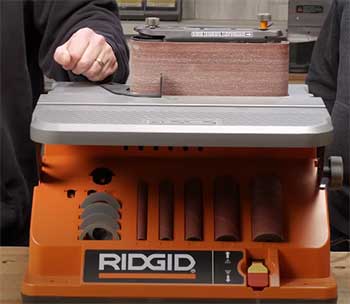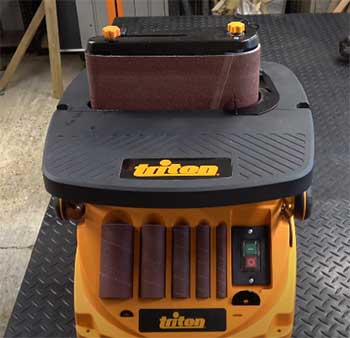Triton Oscillating Sander comes with a 3.5 Amps motor, whereas Ridgid Oscillating Sander has a 5 Amps motor. Ridgid is heavier than Triton. You can use Triton for lightweight to moderate sanding and Ridgid for heavy-duty jobs.
One of the primary reasons DIYers and professionals use oscillating sanders is to avoid burns and band marks on the wood. Many top brands manufacture this sanding tool.
Here we come up with a comparison of Triton and Ridgid oscillating sander to help you decide the best one.
A Quick Comparison Table
Thinking of how Triton Oscillating Sander is different from Ridgid? Here is a small table to give you a brief idea.
| Specifications | Triton Oscillating Sander | Ridgid Oscillating Sander |
| Power | 3.5 Amps. | 5 Amps. |
| Oscillations Per Minute | 58/min | 60/min |
| Weight | 30.3 lbs | 40 lbs |
| Table Tilts | 0-45° | 0-48º |
| Feed Rate | 1575 FPM | 1,350 FPM |
| Spindle Speed | 1925 RPM | 1,725 RPM |
| Flexibility | Higher | Moderate |
| Durability | Decent | Higher |
| Price | Affordable | A little expensive |
A Comprehensive Comparison Between Triton And Ridgid Oscillating Sander
Considering many vital aspects of Oscillatingsanding tools is necessary before choosing a particular option. Below is an in-depth differentiation session between these two brands.
- Power

Triton oscillating sanders feature a 3.5 Amps motor, perfect for sanding, polishing, and buffing tasks.
You can use it for any standard sanding projects.
In contrast, Ridgid oscillating sanders come with a 5 Amps motor.
It will provide higher output to finish the job quickly.
- Oscillations Per Minute
Triton sanding tools provide 58 Oscillations Per Minute, whereas Ridgid has 60 Oscillations Per Minute.
Hence, the first one can rotate and oscillate more quickly in and out.
However, they have almost similar OPM performance. This makes them ideal for sanding curves and contours without using your hands.
- Table Tilts
A Triton oscillating sander allows you to tilt its built-in table up to 45 degrees. You can sand your preferred workpiece horizontally and vertically.
On the contrary, the Ridgid oscillating sander can be tilted up to 48 degrees. Hence, you can keep your pieces in a square or precise shape while sanding.
- Belt Feed Rate
Triton oscillating sanders come with a 1575 feed per minute rate, whereas Ridgid has 1,350 FPM. The higher speed of Triton allows you to cut more quickly and more cutting edges.
A higher RPM rate is better in many aspects. But, they are prone to generate excessive heat. This may lead to a breakdown of the belt grinder.
- Spindle Speed
With Triton oscillating sanders, you can get up to 1925 RPM. This comes in handy when you want to sand the workpiece more quickly.
On the flip side, Ridgid oscillating sanders offer up to 1,725 RPM. Their moderate speed allows you to get more power and avoid poor surface finish.
- Flexibility
Compared to Ridgid, Triton oscillating sanders are more versatile due to their lightweight constructions. You can move the unit more quickly without pressuring your hand too much.
But Ridgid oscillating sanders are also an excellent choice to get rid of roughness and prepare the workpieces. It can also show a reliable performance for quick stock removal.
- Durability
Triton oscillating sanders come with a solid and rugged plastic body. But, it will not be as durable as Ridgid. After all, Ridgid has a metal body.
Though Ridgid sanders are heavier, they can take a lot of abuse. This makes them a perfect choice for regular heavy usage. You will see minimal quality deterioration over time.
- Price
Triton oscillating sanders have an affordable price than Ridgid oscillating sanders. But, it is worth the money you spend. The unit has many user-friendly features for convenient sanding.
Whether it is faces, edges, inside and outside curves, or contours, you can achieve burn-free and quick finishes using Ridgid sanding tools. Its ball-bearing construction ensures smooth operation.
Which Oscillating Sander Is The Best For Your Job?

Our sanding tasks vary.
So, our requirements will differ too.
Before choosing a particular oscillating sanding, you must first determine the job you will handle.
A Triton oscillating sander will be a perfect choice if you want to work on standard and moderate types of work.
It will give you a lot of flexibility due to its lightweight construction.
On the contrary, a Ridgid oscillating sander appears a better option if you regularly handle heavy-duty tasks such as removing several inches of roughness from the work surface.
Frequently Asked Questions (FAQ)
WEN, Ridgid, Triton, JET, EJWOX, Grizzly, and Delta are well known for making top-quality oscillating spindle sanders.
Oscillating spindle sanders are mainly designed to sand the edges, inside & outside curves, and contours or wood pieces. They can provide intricate grooves and smooth finishes.
An oscillating belt sander is mainly used for trimming, leveling, sanding, or shaping different types of wood and rough surfaces.
Bottom Lines
Choosing the suitable oscillating sander will make your carpentry project easygoing. Triton appears to be a flexible and standard choice, whereas Ridgid is better for professional purposes
Hopefully, you got a complete overview of the Triton vs. Ridgid oscillating sander. Make sure you consider its working requirements and additional features of the sanding tools.
